
|
Paneles de Discussión
Paneais de Discussio |
Prevention of incipient diabetic nephropathy by high dose thiamine and BenfotiaminePaul J. ThornalleyDepartment of Biological Sciences, University of Essex, Essex, U.K.thorp@essex.ac.uk
Nephropathy is a common complication of diabetes mellitus associated with a high risk of cardiovascular disease and mortality. Studies from my research team showed recently that stimulation of the reductive pentosephosphate pathway by therapy with thiamine and the thiamine monophosphate derivative Benfotiamine at high dose (7 and 70 mg/kg) prevented the development of incipient nephropathy in experimental diabetes.
Diabetes was associated with mild thiamine deficiency and decreased expression of the thiamine pyrophosphate-dependent enzyme transketolase. High dose thiamine and Benfotiamine therapy increased transketolase expression in renal glomeruli, activating the reductive pentosephosphate pathway and increasing the conversion of triosephosphates to ribose-5-phosphate. This was associated with decreased glomerular protein kinase C activity, protein glycation and oxidative stress - three major pathways of biochemical dysfunction in hyperglycemia, and potent inhibition of the development of microalbuminuria. Benfotiamine also inhibited diabetes-induced hyperfiltration. This was achieved without change in elevated plasma glucose concentration and glycated haemoglobin in the diabetic state. High dose thiamine and Benfotiamine therapy is a potential novel strategy for the prevention of clinical diabetic nephropathy. (This contribution is based on extracts from the recent paper by the author and co-workers: Babaei-Jadidi, R., Karachalias, N., Ahmed, N., Battah, S., and Thornalley, P. J. Prevention of incipient diabetic nephropathy by high dose thiamine and Benfotiamine. Diabetes 52, 2110-2120, 3003)
Nephropathy develops progressively in diabetic patients such that it becomes a major contributory risk factor for death from cardiovascular complications [1] . It is a common and disabilitating complication of diabetes mellitus with no effective therapy. The progression of nephropathy in diabetes from the reference time point of diagnosis of diabetes is:
Diabetes is a common cause (30%) of chronic renal failure and is likely to be of increasing importance in the future as diabetes incidence increases- especially with early onset [2]. Glycemic control is a risk factor for the development of incipient nephropathy and progression from incipient to overt nephropathy in type 1 and type 2 diabetes [4;5]. Health care services have now prioritized the decreasing the risk of nephropathy by tight control of blood glucose and blood pressure and aggressive intervention to counter dyslipidaemia – as reflected in position statement reports [6;7]. This is not always achievable – particularly because of limitations of current drug therapy. Hence, diabetic nephropathy is still a significant clinical problem that needs new effective therapy urgently and preferably therapies working independent of existing strategies. One such therapy emerging is high dose thiamine supplements. The link of hyperglycemia to renal dysfunction and development of nephropathy High plasma glucose concentration leads to high cytosolic glucose concentration in renal endothelial cells and pericytes with consequent biochemical dysfunction: activation of protein kinase Cb, hexosamine and polyol pathways, metabolic pseudohypoxia, mitochondrial dysfunction and oxidative stress, and accumulation of advanced glycation endproducts (AGEs) [8] – Figure 1  Figure 1. Biochemical dysfunction in hyperglycemia linked to diabetic nephropathy. Increased concentrations of triosephosphate glycolytic intermediates, glyceraldehyde-3-phosphate (GA3P) and dihydroxyacetonephosphate (DHAP), is the trigger for these processes. A pharmacological strategy that counters triosephosphate accumulation in hyperglycemia would suppress multiple pathogenic pathways and prevent the development of diabetic nephropathy. Activation of the reductive pentosephosphate pathway (PPP) by high dose thiamine therapy may achieve this by increasing transketolase (TK) activity and stimulating the conversion of GA3P and fructose-6-phosphate (F6P) to ribose-5-phosphate (R5P) – Figure 2.  Figure 2. Reversal of biochemical dysfunction in hyperglycemia by high dose thiamine. We first established this response in cell culture [9] and then investigated the effect of high dose thiamine and Benfotiamine therapy on the development of incipient nephropathy in the streptozotocin (STZ)-induced diabetic rat model of diabetes with moderate insulin therapy.  Figure 2. Reversal of biochemical dysfunction in hyperglycemia by high dose thiamine. Incipient nephropathy developed over a 24-week period in the STZ diabetic rats, as judged by hyperfiltration and microalbuminuria, and both high dose thiamine and Benfotiamine therapy prevented it [10]. STUDY DESIGN  Figure 3. Study design: induction of diabetes, study groups and thiamine/Benfotiamine dosing.
Thiamine and Benfotiamine dosing of STZ diabetic rats. Animal study groups in this investigation were: normal controls (C), normal controls with high dose thiamine and Benfotiamine therapy (70 mg/kg per day, CT70 and CB70 respectively), diabetic controls (DC) and diabetics given high dose thiamine and Benfotiamine therapy (7 and 70 mg/kg per day, DT7 and DT70, and DB7 and DB70, respectively). At baseline, dietary thiamine exceeded the recommended daily allowance by ca. 6-fold (C), 9-fold (D), 20-fold (DT7), 140-fold (CT70 and DT70), and in thiamine equivalents 20-fold (DB7), and 100-fold (CB70 and DB70). Body weights of STZ diabetic and control rats. Mean body weights in the control groups increased from 268 and 235 g at baseline to 712 and 607 g at after 24 weeks in thiamine and Benfotiamine dosing studies, respectively; this was not changed significantly by thiamine and Benfotiamine therapy. Mean body weights in the diabetic controls increased from 268 and 243 g at baseline to 351 and 318 g in thiamine and Benfotiamine dosing studies, respectively; similar increases in mean body weight were found for diabetic rats with high dose thiamine and Benfotiamine therapy. Diabetic state established. The diabetic rats had the characteristics of the diabetic state in both studies: increased plasma glucose concentration and increased glycated hemoglobin HbA1. These increased levels in the diabetic rats were not changed by high dose thiamine and Benfotiamine therapy - Figures 4 and 5. 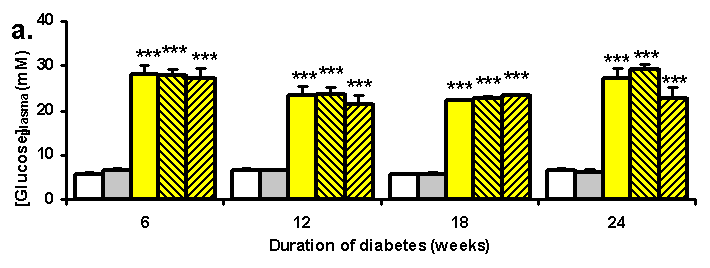
 Figure 4. Effect of high dose thiamine (a.) and Benfotiamine (b.) therapy on plasma glucose concentration in STZ diabetic rats and controls. Key:  , Control; , Control;  + 70 mg/kg thiamine or Benfotiamine; + 70 mg/kg thiamine or Benfotiamine; , diabetic control; , diabetic control; , diabetic + 7 mg/kg thiamine or Benfotiamine; and , , diabetic + 7 mg/kg thiamine or Benfotiamine; and , diabetic + 70 mg/kg thiamine or Benfotiamine. diabetic + 70 mg/kg thiamine or Benfotiamine.

 Figure 5. Effect of high dose thiamine (a.) and Benfotiamine (b.) therapy on glycated hemoglobin HbA1 in STZ diabetic rats and controls. Key:  , Control; , Control;  + 70 mg/kg thiamine or Benfotiamine; + 70 mg/kg thiamine or Benfotiamine; , diabetic control; , diabetic control; , diabetic + 7 mg/kg thiamine or Benfotiamine; and , , diabetic + 7 mg/kg thiamine or Benfotiamine; and , diabetic + 70 mg/kg thiamine or Benfotiamine. diabetic + 70 mg/kg thiamine or Benfotiamine.Prevention of microalbuminuria and proteinuria by high dose thiamine and Benfotiamine. STZ diabetic rats on insulin maintenance therapy develop microalbuminuria over 24 weeks . Microalbuminuria was evident in the diabetic rats from 6 – 24 weeks, increasing from normoalbuminuria (2.0 – 2.2 mg albumin/24 h) to 12 -17 mg/24 h at 6 weeks with a further progressive increase to 19 - 33 mg/24 h at 24 weeks (P<0.01)<>. Thiamine and Benfotiamine therapy inhibited the development of microalbuminuria by 70 – 80% with no dose-response relationship evident (P<0.01)<> – Figure 6, a and b. Proteinuria showed similar changes, albeit with excreted amounts of protein approximately 5-fold higher than for intact albumin. Overall, there was no marked difference in potency between thiamine and Benfotiamine. 
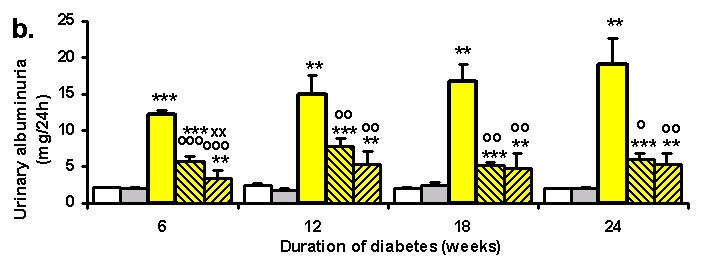 Figure 6. Effect of high dose thiamine (a.) and Benfotiamine (b.) therapy on the development of microalbuminuria in STZ diabetic rats and controls. Key:  , Control; , Control;  + 70 mg/kg thiamine or Benfotiamine; + 70 mg/kg thiamine or Benfotiamine; , diabetic control; , diabetic control; , diabetic + 7 mg/kg thiamine or Benfotiamine; and , , diabetic + 7 mg/kg thiamine or Benfotiamine; and , diabetic + 70 mg/kg thiamine or Benfotiamine. diabetic + 70 mg/kg thiamine or Benfotiamine.Hyperfiltration developed in the diabetic controls. This was not prevented by thiamine but it was prevented by Benfotiamine at 6 – 18 weeks. At 24 weeks of Benfotiamine therapy, mild hyperfiltration had developed. Thiamine status, transketolase activity and expression, and activation of the reductive pentosephosphate pathway. We assessed the effect of high dose thiamine and Benfotiamine therapy on thiamine status of the study group rats by measuring the plasma concentrations of thiamine and thiamine monophosphate (TMP); thiamine pyrophosphate (TPP) was not detectable in blood plasma. We discovered the previously unrecognized characteristic of STZ diabetic rats that they are thiamine deficient – the plasma thiamine concentration was decreased 69% in diabetic rats in the thiamine dosing, with respect to normal controls. This was due to increased urinary excretion of thiamine: urinary thiamine excretion was 0.55 mmol/24 h in controls and 2.28 mmol/24 h in diabetic rats (P<0.01).<> There was an associated 8-fold increase in the renal clearance of thiamine in STZ diabetic rats, with respect to controls - 0.51 versus 4.03 ml/min (P<0.01). <> This was prevented by high dose thiamine therapy, producing a dose dependent increase in the plasma concentration of thiamine: 7 mg/kg thiamine normalized and 70 mg/kg thiamine supra-normalized plasma thiamine levels in diabetic rats - Figure 7a. Similar effects were found with high dose Benfotiamine therapy. 
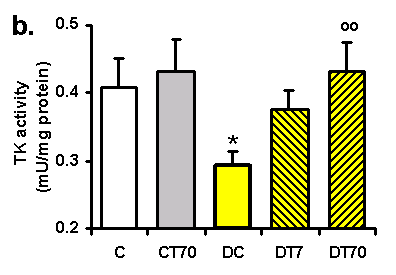 Figure 7. Plasma thiamine and glomerular transketolase activity in STZ diabetic rats: effect of high dose thiamine therapy. Key:  , Control; , Control;  + 70 mg/kg thiamine or Benfotiamine; + 70 mg/kg thiamine or Benfotiamine; , diabetic control; , diabetic control; , diabetic + 7 mg/kg thiamine or Benfotiamine; and , , diabetic + 7 mg/kg thiamine or Benfotiamine; and , diabetic + 70 mg/kg thiamine or Benfotiamine. diabetic + 70 mg/kg thiamine or Benfotiamine.Diabetic rats had decreased TK activity (thiamine study, -29%, P<0.05, P<0.001),<> which was normalized by thiamine therapy – Figure 7b. There was also a significant but small “thiamine effect” on glomerular TK activity in diabetic rats only: thiamine study 7.4 ± 3.3% (0.05). Decrease in TPP co-factor availability, however, as assessed by the “thiamine effect”, did not account for most of the decreased glomerular TK activity in diabetic rats and reversal of this by high dose thiamine and Benfotiamine therapy. Rather, TK expression was decreased in diabetic rats and supra-normalized in thiamine- and Benfotiamine-treated control and diabetic rats. Decreased TK activity was associated with a decreased R5P/GA3P concentration ratio that was increased significantly in both control and diabetic rats by thiamine therapy. The R5P/GA3P concentration ratio (mean ± SEM) in red blood cells was: C 0.91 ± 0.19, CT70 3.05 ± 0.78 (P<0.05 <>with to normal control), and DC 0.51 ± 0.15, DT7 2.12 ± 0.55 (P<0.05)<> and DT70 1.71 ± 0.41 (P<0.05<> with respect to diabetic control). Reversal of biochemical dysfunction in hyperglycemia by high dose thiamine and Benfotiamine therapy. Using an assay of in situ PKC activity, we found increased glomerular PKC activity in STZ diabetic rats, with respect to controls (thiamine dosing study 38 ± 3%, Benfotiamine dosing study 54 ± 6%). This was reversed in a dose-dependent manner by thiamine and Benfotiamine therapy – Figure 8, a and b. Both membrane and cytosolic PKC activities were increased in the diabetic controls and increases in both were reversed by high dose thiamine and Benfotiamine. 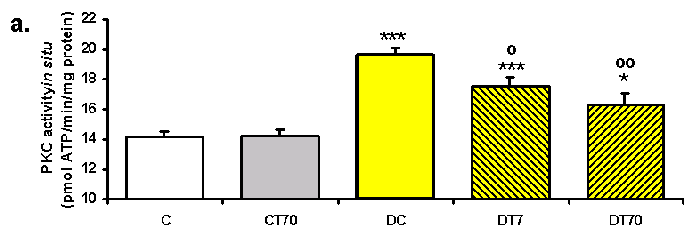
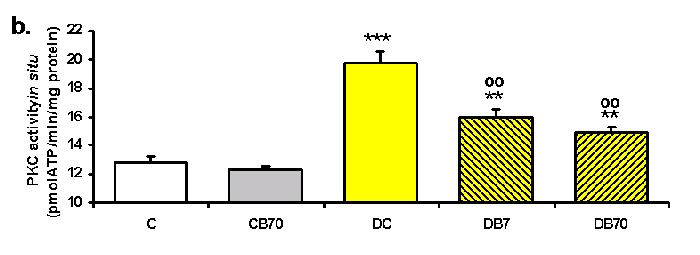 Figure 8. Effect of high dose thiamine (a.) and Benfotiamine (b.) therapy on the in situ glomerular protein kinase C activity of STZ diabetic rats. Key:  , Control; , Control;  + 70 mg/kg thiamine or Benfotiamine; + 70 mg/kg thiamine or Benfotiamine; , diabetic control; , diabetic control; , diabetic + 7 mg/kg thiamine or Benfotiamine; and , , diabetic + 7 mg/kg thiamine or Benfotiamine; and , diabetic + 70 mg/kg thiamine or Benfotiamine. diabetic + 70 mg/kg thiamine or Benfotiamine.Dicarbonyl compounds such as methylglyoxal, glyoxal and 3-deoxyglucosone are implicated in carbonyl stress and increased formation of AGEs in diabetes, linked to the development of diabetic nephropathy. Methylglyoxal concentration is increased by the degradation of abnormal high concentrations of GA3P and DHAP in cells suffering cytosolic hyperglycemia . High dose thiamine therapy was therefore expected to decrease the plasma concentration of methylglyoxal and this was indeed found. Glyoxal and 3-deoxyglucosone were also increased in the plasma of STZ diabetic rats and surprisingly the increased plasma concentrations of these glycating agents were also decreased by thiamine – Figure 9.
 Figure 9. Effect of high dose thiamine on the plasma concentrations of a-oxoaldehyde glycating agents in the plasma of STZ diabetic rats of. Key:  , Control; , Control;  + 70 mg/kg thiamine or Benfotiamine; + 70 mg/kg thiamine or Benfotiamine; , diabetic control; , diabetic control; , diabetic + 7 mg/kg thiamine or Benfotiamine; and , , diabetic + 7 mg/kg thiamine or Benfotiamine; and , diabetic + 70 mg/kg thiamine or Benfotiamine. diabetic + 70 mg/kg thiamine or Benfotiamine.We determined markers of glycation (fructosyl-lysine FL and advanced glycation endproducts AGEs in glomerular protein) and oxidative stress (plasma protein thiols) in STZ diabetic rats with high dose thiamine and Benfotiamine therapy. The methylglyoxal-derived AGEs, MG-H1 and CEL, were increased ca. 2-fold in glomerular protein of diabetic rats and normalized in a dose-dependent manner by thiamine and Benfotiamine – Figure 10, a and b. There were smaller increases in CML in diabetic controls of borderline significance (thiamine study - 0.50 ± 0.19 versus 0.27 ± 0.11 mmol/mol lys; Benfotiamine study – 0.42 ± 0.17 versus 0.26 ± 0.12 mmol/mol lys; P<0.05).<> These increases were partially reversed by thiamine and Benfotiamine therapy. Glomerular protein FL was increased in diabetic controls but was not decreased by thiamine and Benfotiamine therapy. 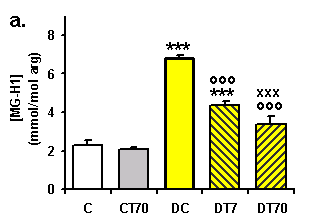
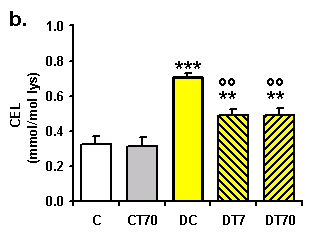 Figure 10. Effect of high dose thiamine on the glomerular protein concentrations of the advanced glycation endproducts MG-H1 (a.) and CEL (b.). Key:  , Control; , Control;  + 70 mg/kg thiamine or Benfotiamine; + 70 mg/kg thiamine or Benfotiamine; , diabetic control; , diabetic control; , diabetic + 7 mg/kg thiamine or Benfotiamine; and , , diabetic + 7 mg/kg thiamine or Benfotiamine; and , diabetic + 70 mg/kg thiamine or Benfotiamine. diabetic + 70 mg/kg thiamine or Benfotiamine.The concentration of plasma thiols was measured as a marker of oxidative stress. Plasma protein thiols were decreased in STZ diabetic rats by 30% of control levels in both thiamine and Benfotiamine dosing studies. Benfotiamine therapy (50 mg/kg) reversed this decrease significantly but not thiamine (7 and 70 mg/kg) and Benfotiamine (7 mg/kg) did not – Figure 11, a and b. 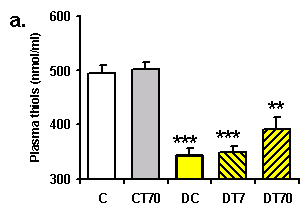
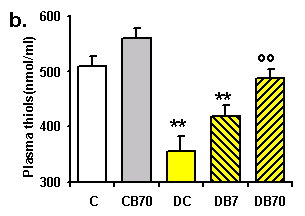 Figure 11. Effect of high dose thiamine (a.) and Benfotiamine (b.) therapy on plasma thiol concentration of STZ diabetic rats. Key:  , Control; , Control;  + 70 mg/kg thiamine or Benfotiamine; + 70 mg/kg thiamine or Benfotiamine; , diabetic control; , diabetic control; , diabetic + 7 mg/kg thiamine or Benfotiamine; and , , diabetic + 7 mg/kg thiamine or Benfotiamine; and , diabetic + 70 mg/kg thiamine or Benfotiamine. diabetic + 70 mg/kg thiamine or Benfotiamine.
These observations suggest that high dose thiamine repletion suppressed the development of incipient nephropathy in experimental diabetes in which effects on the PKC, glycation and oxidative stress pathways were involved. We found similar effects on human mesangial cells in hyperglycemic culture in vitro – to be published. The primary intervention was the prevention of thiamine deficiency and induction of TK expression with consequent activation of the reductive PPP shunt. It is remarkable that these effects were achieved by increasing the dietary availability of thiamine to diabetic rats by as little as 20 times the minimum daily allowance – although this was sufficient to prevent thiamine deficiency. Diabetes was associated with mild thiamine deficiency due to increased renal clearance of thiamine. This may be due to increased thiamine washout by high diuresis and/or impairment of the proximal tubule thiamine/H+ antiport activity that reclaims thiamine from the glomerular filtrate. Thiamine deficiency exacerbated the development of diabetic nephropathy. Studies of clinical diabetes to date suggest that a significant proportion of diabetic patients have mild thiamine deficiency and this may be corrected by therapy with thiamine and thiamine derivatives [11-13] . However, thiamine supplements are not generally taken by diabetic patients currently. Our study suggests that such thiamine deficiency may exacerbate the risk of developing diabetic nephropathy.
I propose that clinical diabetic subjects should avoid becoming thiamine deficient, even weakly so, and that high dose thiamine repletion should be considered for therapy to prevent the development of clinical diabetic nephropathy.
1 Parving, H.-H., Harrington, J. T., Lewis, J., Boner, G., Lewis, E. J., Viberti, G., Gilbert, R., Raz, I., Cooper, M., and Rossing, P. (2001) Diabetic nephropathy: prevention and treatment. Kidney Internat. 60, 2041-2055
2 Stengel, B., Billon, S., van Dijk, P. C. W., Jager, K. J., Dekker, F. W., Simpson, K., and Briggs, J. K. (2003) Trends in the incidence of renal replacement therapy for end-stage renal disease in Europe, 1990-1999. Nephrol.Dialysis Transplant. 18, 1824-1833
3 Adler, A. I., Stevens, R. J., Manley, S. E., Bilous, R. W., Cull, C. A., Holman, R. R., and UK Prospective Diabetes Study Group (2003) Development and progression of nephropathy in type 2 diabetes: The United Kingdom Prospective Diabetes Study (UKPDS 64). Kidney Internat. 63, 225-252
4 The Diabetes Control and Complications Trial Research Group (1993) The effect of intensive treatment of diabetes on the development and progression of long-term complications in insulin-dependent diabetes mellitus. New Engl.J.Med. 327, 977-986
5 Stratton, I. M., Adler, A. I., Neil, H. A. W., Matthews, D. R., Manley, S. E., Cull, C. A., Hadden, D., Turner, R. C., and Holman, R. R. (2002) Association of glycaemic with macrovascular and microvascular complications of type 2 diabetes (UKPDS 35): prospective observational study. BMJ 321, 405-412
6 Department of Health, UK Government. (2002) National Service Framework For Diabetes: delivery strategy. 1-40.
7 American Diabetes Association (2003) Position statements: Standards of medical care for patients with diabetes mellitus. Diabetes Care 26, S33-S50
8 Brownlee, M. (2001) Biochemistry and molecular cell biology of diabetic complications. Nature 414, 813-820
9 Thornalley, P. J., Jahan, I., and Ng, R. (2001) Suppression of the accumulation of triosephosphates and increased formation of methylglyoxal in human red blood cells during hyperglycaemia by thiamine in vitro. Japan.J.Biochem. 129, 543-549
10 Babaei-Jadidi, R., Karachalias, N., Ahmed, N., Battah, S., and Thornalley, P. J. (2003) Prevention of incipient diabetic nephropathy by high dose thiamine and Benfotiamine. Diabetes 52, 2110-2120
11 Saito, N., Kimura, M., Kuchiba, A., and Itokawa, Y. (1987) Blood thiamine levels in outpatients with diabetes mellitus. J.Nutr.Sci.Vitaminol. 33, 421-430
12 Havivi, E., Bar On, H., Reshef, A., and Raz, I. (1991) Vitamins and trace metals status in non insulin dependent diabetes mellitus. Internat.J.Vit.Nutr.Res. 61, 328-333
13 Valerio, G., Franzese, A., Poggi, V., Patrini, C., Laforenza, U., and Tenore, A. (1999) Lipophilic thiamine treatment in longstanding insulin-dependent diabetes mellitus. Acta Diabetol. 36, 73-76
Author contacts: Professor Paul J. Thornalley, Disease Mechanisms and Therapeutics Research Group, Department of Biological Sciences, University of Essex, Central Campus, Wivenhoe Park, Colchester, Essex CO4 3SQ, U.K. Tel/fax 0044 1206 873010 Mobile 0044 7884331407 E-mail: thorp@essex.ac.uk
http://www.essex.ac.uk/bs/staff/thornalley/index.htm
|